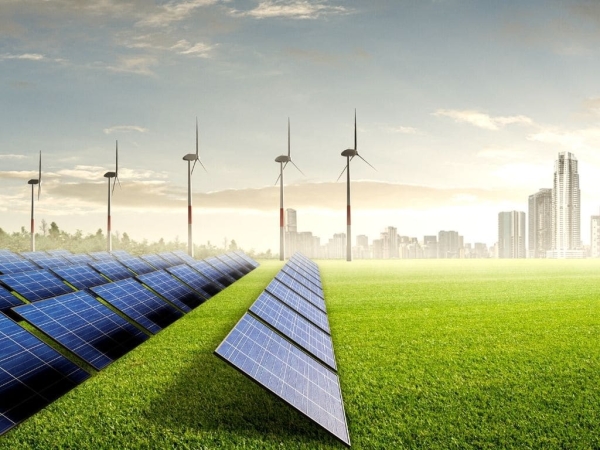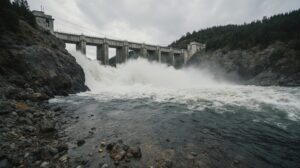Central Asia is advancing toward a sustainable future by incorporating renewable energy sources into its national energy strategies. The region is systematically increasing its green energy share to address rising domestic needs and export goals, amid growing demands and limited resources.

Charles Cormier, World Bank Regional Director for Infrastructure, emphasized the need for large-scale energy efficiency measures, stating;
“The recent energy crisis has highlighted the urgent need for large-scale energy efficiency measures that conserve scarce natural resources. Energy efficiency remains the most accessible and cost-effective way to meet energy needs compared to new energy generation.”
Kazakhstan: Renewable Energy Leader
Kazakhstan is advancing its wind and solar energy sectors. In the first half of 2024, the country generated 3.896bn kWh from renewable sources, a 16% increase from the previous year. Wind power contributed 2.325bn kWh, followed by solar (974.9mn kWh) and hydroelectric (595.36bn kWh) plants.
The government aims to raise renewable energy’s share to 15% by 2030 and 50% by 2050. Despite this, there are discussions about a potential nuclear power plant, with President Kassym-Jomart Tokayev planning a national referendum on the issue.
Kazakhstan’s vast windswept steppes offer favorable conditions for wind power, with an estimated potential of 920bn kWh annually.
[telegram_embed_post link=”Kazakhstan’s green economy investments soar to $418mn in 2023″]
Uzbekistan: Green Energy Horizons
Uzbekistan is actively seeking international investment to advance green energy initiatives. In 2024, the country launched several major projects in collaboration with international partners such as PowerChina and Saudi Arabia’s ACWA Power, including the construction of its first green hydrogen production facility.
As part of its green energy reforms, Uzbekistan has commissioned 10 solar and wind power plants with a combined capacity of 2.4 gigawatts. These plants produced 1.6 billion kilowatt-hours of green energy in the first half of 2024, resulting in a savings of 500mn cubic meters of gas.
In 2021, Uzbekistan strengthened its commitments under the Paris Agreement, aiming to reduce greenhouse gas emissions per unit of GDP by 35% by 2030 from 2010 levels, up from the previously planned 10% reduction.
Azerbaijan: Regional Energy Contributor
Azerbaijan generated 2.032bn kWh of renewable energy in early 2024, with major solar and wind projects underway, including a new 230 MW solar plant. The country is also developing a green energy corridor to Europe, enhancing regional energy security and economic potential.
Kyrgyzstan and Tajikistan: Hydropower Potential
Kyrgyzstan and Tajikistan also have hydropower potential. Surveys of rare earth element deposits and identified areas suggest these countries may hold significant untapped resources, boosting their role in the green energy transition.
In Kyrgyzstan, hydroelectric power plants generate over 90% of the country’s electricity. Tajikistan is advancing its hydropower sector and increasing its renewable energy use.
Central Asia has a minimal carbon footprint, accounting for less than 1% of global emissions. As part of its 2021 Nationally Determined Contribution (NDC), Kyrgyzstan aims to cut greenhouse gas emissions by 15.97% by 2025 and 43.62% by 2030 with international assistance, and President Sadyr Japarov has pledged carbon neutrality by 2050, mainly through hydroelectric development.
Tajikistan’s original NDC set an emission ceiling target: an unconditional goal to reduce emissions to 80-90% of 1990 levels and a conditional goal to limit them to 65-75% of 1990 levels.
Turkmenistan: Investment in Green Projects
Turkmenistan is investing in solar and wind projects and has committed to reducing methane emissions under the Global Methane Commitment. The country aims to cut greenhouse gas emissions by 20% by 2030 compared to 2010 levels.
Regional Initiatives and Cooperation
Kazakhstan, along with Uzbekistan and Azerbaijan, is developing its electricity export potential while also addressing challenges in securing adequate power for domestic growth. Although a date for a national referendum has not been set, Kazakhstan’s Energy Ministry has released a draft agreement for a strategic green energy partnership with Azerbaijan and Uzbekistan for public review. This agreement builds on a memorandum of understanding signed by the three countries in May.
In contrast, Kyrgyzstan, Uzbekistan, and Tajikistan, while known for their uranium deposits, currently focus on reclaiming past mining sites rather than active mining. This approach reflects the region’s commitment to sustainable development. Kazakhstan, which holds 13% of the world’s uranium reserves, leads in uranium production, meeting a substantial portion of annual demand from Europe and the United States. With more than 56 identified rare earth element (REE) deposits and reserves exceeding 450,000 tonnes, Kazakhstan’s role in the green energy transition is expanding.
In June 2024, the World Bank launched a regional initiative to enhance energy efficiency, aiming to provide secure, affordable, and clean energy in Europe and Central Asia. The 10-year “Europe and Central Asia Energy Efficiency Programme” (E3 Programme) will work alongside the Europe and Central Asia Renewable Energy Scale-up (ECARES) programme. E3 will focus on reducing energy demand, while ECARES will concentrate on clean energy supply. The E3 programme is expected to save over 63 terawatt hours of energy and cut CO2 emissions by 18.7mn metric tons.
Central Asia is showing strong cooperation in green energy, with Kazakhstan, Azerbaijan, and Uzbekistan signing a memorandum for a high-voltage power transmission line across the Caspian Sea to export electricity to Europe. This project will enhance the region’s export potential and energy security, reflecting a growing commitment to green energy across the region.




